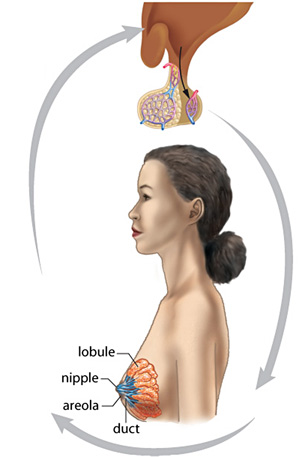Module 4
1. Module 4
1.13. Page 2
Module 4—From Fertilization to Birth
 Explore
Explore
To understand the events of labour, parturition, and lactation, complete the following Read and Watch and Listen activities. According to your personal learning style, you may choose to prepare notes, flow charts, or diagrams to summarize this information. Make sure you save the answers to the following Self–Check activities in your course folder. These feedback loops are an excellent way to summarize information.
 Read
Read
Read “Parturition: Delivery of the Baby” on pages 523 to 526 of the textbook.
 Watch and Listen
Watch and Listen
To review the concepts of this Module, watch the video, “Fetal Development and Birth: An Amazing Transition.” Pay particular attention to the roles of nerve stimulation and hormone control in both parturition and lactation. Use the information from the video to complete your notes. You may be required to enter a username and password in order to view the video. Contact your teacher for this information.
 Self-Check
Self-Check
SC 1. Label the following positive feedback mechanism of hormonal control of parturition. File your work in your course folder.
Positive Feedback Mechanisms Controlling Parturition

SC 2. Label the following feedback loop of the mechanism for milk production and lactation.
Milk Production and Secretion

Inquiry into Biology (Whitby, ON: McGraw-Hill Ryerson, 2007), 526, fig. 15.16. Reproduced by permission.
 Self-Check Answers
Self-Check Answers
SC 1.

This diagram outlines positive feedback mechanisms that are believed to control parturition. Despite advances in technology, understanding of the factors that initiate and control parturition in humans remains incomplete.
SC 2.
Milk Production and Secretion Answer Key

Inquiry into Biology (Whitby, ON: McGraw-Hill Ryerson, 2007), 526, fig. 15.16. Reproduced by permission.
 Discuss
Discuss
In your course discussion area, discuss one, some, or all of the following questions.
D 1. Why do many women choose to give birth in water?
D 2. How do you feel about men becoming impregnated? (Yes, it is happening.)
D 3. How would a man deliver a baby?
D 4. What is a wet nurse, and why were they used?
D 5. Present technology allows for conception and birth to be controlled. What are the advantages and disadvantages of controlling these processes?
 Self Check
Self Check
Did you know that the greatest number of children born to one woman is 69? In the 1700s a woman from Russia had 16 sets of twins, 7 sets of triplets, and 4 sets of quadruplets!
SC 3. Check your understanding of parturition and lactation by completing questions 29 to 32 on page 526 of your textbook.
 Self-Check Answers
Self-Check Answers
29. During parturition (birth), estrogen and progesterone levels drop and prostaglandins cause the release of oxytocin (these two hormones result in uterine contractions).
30. A Caesarian section is a surgical procedure where the mother's abdomen and uterus are opened so that the baby can be delivered when a natural birth is unsafe. (A Caesarian section may be required if the mother has an STI, or if the mother has a small pelvis, or if the baby is in breech position or has the umbilical cord wrapped more than once around its neck.)
31. Lactation is the formation and secretion of breast milk in the mother.
32. Oxytocin causes contractions in the mammary lobules, enabling the mother's milk to flow to the milk ducts.
Inquiry into Biology (Whitby, ON: McGraw-Hill Ryerson, 2007), TRM Pg 526. Reproduced by permission.